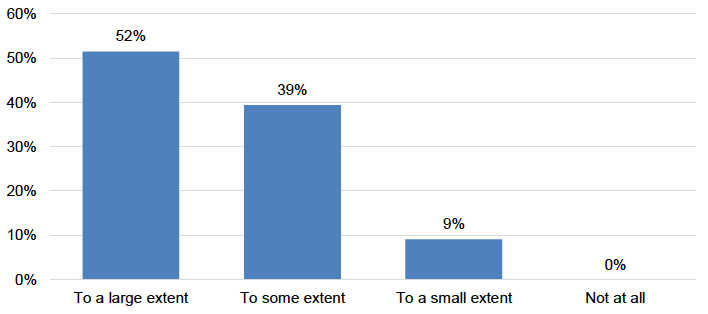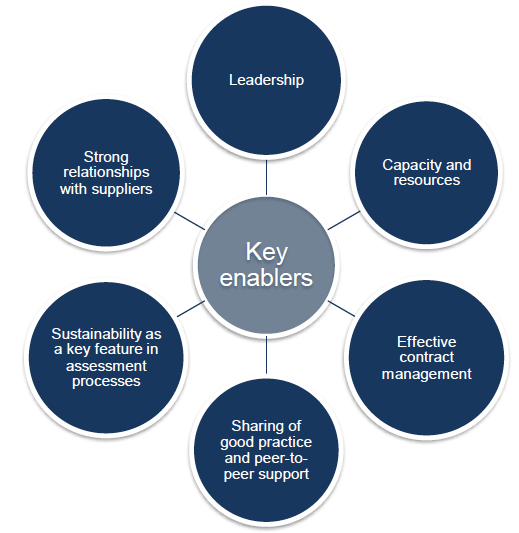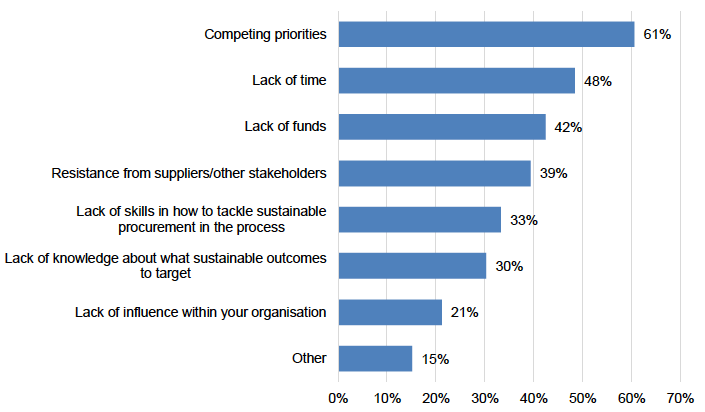Sustainable procurement duty - impact and value analysis: main report
Analysis of the impact and value of the sustainable procurement duty in procurement.
Chapter 5: Experiences of implementing the Duty
Experiences of implementation of the Duty
In our survey of public bodies, we asked respondents to indicate the extent to which their organisation has embedded the Duty into its procurement strategy. As Figure 5.1 below indicates, over half of respondents (17, 52%) said that the Duty has been embedded to a large extent.

This is positive and suggests that good progress is being made. Furthermore, 88 public bodies (80%) that produced an annual procurement report in 2018-19 described how they intended to meet the Duty in terms of economic, social and environmental wellbeing in their procurement strategies. This represents a slight improvement on 2017-18 when this figure was 74% (85 public bodies).
In this chapter, informed by discussions with key informants, case study areas and the survey, we reflect on people’s experiences of implementing the Duty to date.
There was significant consistency of opinion across the interviews conducted with the vast majority describing the Duty as “young”. While interviewees acknowledged that progress has been made, feedback frequently suggested that more progress needs to be made and the speed at which this happens needs to increase.
“Procurement professionals and others haven’t pushed it as far as they could” (interviewee)
Feedback suggests that there is a strong will for the Duty to effect change but that more support is needed to help public bodies to understand how best to implement the Duty for maximum impact. There remain varying levels of knowledge and understanding of obligations and there was a concern that some people still consider it a burden rather than an opportunity. Feedback also indicates that there is strong commitment to procurement as a lever for change at strategic levels in many of the public bodies, but that there is less commitment at operational level (outside procurement teams). Additional support may be required to address this.
“Procurement needs to be seen as an enabler – there needs to be a step change in procurement” (interviewee)
Positive progress was recognised. For example, some interviewees cited good progress having been made recently in relation to fair work but noted that more progress like this needs to be made in relation to other areas of the Duty. This is consistent with the findings of our review of annual procurement reports.
Figure 5.2 below compares information included by public bodies in their 2017-18 and 2018-19 procurement reports about steps they had taken to fulfil elements of the Duty. As can be seen, the direction of travel is generally upwards – across most of the key components of the Duty more is being reported in this year’s reports than in last year’s reports. Interviewees confirmed that progress is being made.

While information in the procurement reports cannot be considered to be a wholly accurate picture of what is being done in practice, this data gives some reassurance that a higher percentage of public bodies are addressing the core elements of the Duty than previously.
Despite increasing between year 1 and 2 reports, two areas stand out due to the significantly lower percentages of public bodies reporting activity against them – innovation, and facilitating the involvement of third sector bodies. As noted in other parts of this report, these are two of the areas most commonly cited by interviewees as remaining challenges to address.
The contribution of the Duty in delivering policy intentions
The Procurement Reform (Scotland) Act 2014, and the Duty set out within it are important to achieving Scotland’s overarching purpose “to create a more successful country, give opportunities to all people living in Scotland, increase the wellbeing of people living in Scotland, create sustainable and inclusive growth and reduce inequalities and give equal importance to economic, environmental and social progress”.[143] The actions of public bodies contribute to individual national outcomes and the Duty is one way in which they do so.
Table 7.1 in Chapter 7 and the matrix provided in Appendix 2 shows examples of the ways in which actions being delivered to address the Duty support the national outcomes. These are by no means comprehensive, and give only a flavour of the ways in which sustainable procurement is delivering on the national outcomes.
However, research participants, including interviewees and survey respondents, noted that systems and processes in many public bodies are not yet sufficiently sophisticated to fully understand how organisations are contributing towards delivering on national priorities through procurement. Tightening the link between policy and procurement staff in an organisation was considered to be central to this going forward.
Furthermore, interviewees emphasised the role of procurement teams in ensuring they work with supplier organisations towards prioritising particular community benefits which link to policy priorities. While some organisations already take this pro-active and collaborative approach, others do not.
Key enablers to effective implementation of the Duty
Research participants identified a range of factors which enable effective implementation of the Duty. There was significant consensus across these and a strong feeling that more needs to be done to ensure that these enablers feature across public bodies. We outline these factors in Figure 5.3 and discuss each of them below.

Leadership
Interviewees described leadership as key to making progress. Links between policy and procurement in an organisation were described as needing to be very tight to ensure success in implementing the Duty.
In local authorities, for example, elected member oversight was considered to be essential but was described as not happening frequently enough. In areas, where leadership was seen to be effective, senior management was described as “putting pressure downwards” to ensure change happens.
Scottish Government’s leadership is also seen as vital in ensuring the Duty is properly implemented. However, a number of research participants commented on the variability in knowledge and practice of the Duty across Scottish Government. Whilst the procurement team itself was widely praised for its role in supporting implementation, other parts of government were described as being less knowledgeable and invested in implementing the Duty.
Capacity and resources
All interviewees cited a lack of capacity or resources as a barrier to implementing the Duty effectively and considered this to be a particular barrier in relation to innovative practice. This related to capacity in procurement teams, more widely across organisations and within supplier organisations, and to skills and knowledge as well as funding - “It’s not always about having more money – it’s about getting more resources to support change”; “Create capacity by increasing partnership working” (interviewees).
Staff turnover was cited as a particular challenge by some research participants – with skills that have been built up being lost to the organisation when someone moves on. This emphasises the importance to public bodies of retaining skilled and experienced procurement staff; and of ensuring, as far as possible, consistent procurement practice among public bodies so that individuals’ skills and experiences are relevant in their new position if they move on.
Good contract management
Good contract management was seen as key to achieving more from the Duty, and understanding the impact that it is having. For example, measuring the impact of community benefit requirements was patchy – being done very well in some public bodies but less effectively (or not at all) in others. This means that there is potentially a lack of accountability for delivery on the part of suppliers and a lack of understanding across buyers of the impact of the Duty.
It is vital that public bodies have measures in place to monitor progress in relation to the implementation of community benefit requirements and other aspects of delivery related to the Duty. Some find this challenging. Feedback from interviewees and survey respondents indicates that a lack of resource – in the form of both time and skills - are barriers to this happening more comprehensively.
Some public bodies raised concerns through the research process about weaknesses in the procurement reporting processes as a mechanism for showcasing practice (although some public bodies did so successfully) while others raised concerns about the amount of information required to be provided and the challenges involved in collating this across the organisation. This emphasises the importance of public bodies making a clear link between contract and supplier management, collecting the information necessary to achieve that, and then using that information to inform reporting around procurement.
It also suggests an overall need for more leadership on this issue, and support to put in place effective impact measurement systems. Some research participants indicated that there may be a need for a centralised point of collection for some of this data.
Sharing good practice
There was consensus across interviewees that learning from each other’s practice was vital to push forward implementation of the Duty and to increase innovation. Interviewees also noted the need to see more examples of good practice to make it more tangible and credible to buyers. Feedback indicated that more needs to be done to bring together buyers, suppliers and commissioners to share practice.
Forums for sharing good practice were highly valued but feedback indicated that there were not enough of these currently taking place. For example, interviewees described the Community Benefits Champions Network, which existed from 2012-17, as really valuable to the third sector but this has since been discontinued.
Sustainability as a key element of assessment processes
Some interviewees observed that the elements of the Duty, such as community benefits requirements, are often treated as an add-on and are not scored in assessment processes (although in some public bodies they are a fully scored part of the process).
There was a sense that the Duty could be given more prominence in assessment - “Weighting it as part of tender processes sends a message that this is very important” (interviewee). However, there was also a recognition that weighting will only be appropriate for some contracts – and that remaining proportionate was important.
Some concerns were also raised about quality and experience lacking in people assessing tender responses.
Strong supplier relationships
Good supplier relations were seen to be central to the success of the Duty and some interviewees noted that building strong relationships with suppliers was key to making progress - “It’s about getting the right ethos into your supply chain”. Interviewees emphasised the importance of effective engagement with suppliers pre- and post-tender stages. Renfrewshire Council (featured in our case study in Appendix 1) is a good example of an organisation investing time and resources in fostering these relationships to affect change.
Some spoke of pushback from suppliers (although this tended to be the exception with feedback generally indicating little resistance from suppliers), but some suppliers were described as “beginning to see the value of this” (interviewee). For example, one supplier in particular was cited by interviewees as an example of a supplier having recognised the competitive advantage that offering community benefits can give.
Some interviewees felt that there was a need for more feedback from suppliers with one suggesting that their views should be reflected in the ministerial report on procurement.
Barriers to implementing the Duty
As might be expected, barriers closely mirrored enablers. Our survey of public bodies we explored the factors that make it challenging to implement the Duty and, as Figure 5.4 below shows, a lack of resources (competing priorities, lack of time and lack of funds) is a key factor. However, resistance from suppliers and a lack of skills and knowledge also featured highly. This resonates with what we heard from key informants and case study areas.

In addition, interviewees highlighted a number of other challenges to implementing the Duty including the following:
- risk aversion – a risk averse culture around procurement was felt to be hindering progress and stifling ambition and innovation in relation to practice. The role of leadership was again seen to be key to addressing this barrier
- lack of ambition – levels of enthusiasm were perceived to be very mixed and while organisations may be complying with the Duty, there was a sense that the level of ambition to use the Duty as a real lever for change was limited in some public bodies – “Some see it as an opportunity, others see it as a burden”
- lack of creativity in approaches to implementing the Duty – creativity was considered by some to be key in delivering greater impact through the Duty
- framework contracts were felt by some to be a barrier (whilst recognising that they can be valuable in some respects) – they were described as “positive if you are on them”, and a “helpful tool for buyers”, but some reported challenges in successfully being appointed to frameworks – especially for SMEs and third sector bodies
- while some interviewees gave examples of public bodies using Quick Quotes as an effective way of involving SMEs, third sector bodies and supported businesses in procurement exercises, some research participants fed back that third sector bodies, particularly social enterprises, do not currently benefit enough from Quick Quotes and there is scope for public bodies to involve them more in these exercises
- public bodies require suppliers to include community benefit requirements in contracts over a certain value, and SMEs, third sector bodies and supported businesses are well-placed to deliver community benefits when they are relevant and proportionate to the contract in question. However, the time and resources involved in delivering community benefits can act as a disincentive for some organisations, particularly SMEs, to bid for smaller contracts where disproportionate or irrelevant community benefits are required. This emphasises the importance of relevancy and proportionality in community benefit requirements.
Contact
Email: socialresearch@gov.scot
There is a problem
Thanks for your feedback